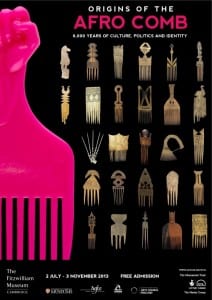‘African Hair Combs’ – a Conservator’s comment
By Edmund Connolly, on 28 October 2013
Guest Blogger: Pia Edqvist
Has anyone seen the exhibition ’Origins of the Afro Comb, 6,000 years of Culture, Politics and Identity’ currently on display at the Fitzwilliam Museum, Cambridge? If so, what did you think?
If not, you must go and see it; the display will be closing on the 3rd November and you do not want to miss this exhibition.
On display is the iconic Black fist comb which was the symbol of the Black Civil Rights and Power Movement during the 1970’s in the USA. Earlier, the Afro comb was not very visible and for this reason it has been assumed that the afro comb was developed during this time. But this exhibition shows that the afro comb dates back to Ancient Egypt. The oldest comb is an Ancient Egyptian comb 5,500 years old which is displayed side by side with the black fist comb. The parallels between these combs are what inspired this exhibition. The connections made between the past and the present make this exhibition extra fascinating. This is also seen in the presentations of oral histories and testimonies within the exhibition which document attitudes towards hair and grooming in the present day. These contributions will also create an archive for the future.
The comb is an object with many different forms and values which often go beyond the actual function, sometimes associated with cultural affiliation, protection and status. These combs are all similar but in themselves unique, and I promise that each and every one of you entering this exhibition will gain a favourite comb but also a fascination for the subject.
To me these combs have a great interest when it comes to their materials of construction and use. As I am the main conservator for this project, my role has been to carry out technical analysis of materials, as well as the condition checking and conservation work needed to enable the safe display of these objects. As a conservator I am able to reveal details about objects which sometimes make the previous owners somewhat visible. On combs I have seen the signs of use like hair but also residues of oil/fat/wax which may be remnants of hair dressings or similar that may have cultural significance. I have also observed the careful choice of materials and attention to detail devoted to the creator; to make sure that the object will be fit for function whatever it may be.
The exhibition is the result of a joint effort between The Fitzwilliam Museum and the Museum of Archaeology & Anthropology, Cambridge. The exhibition also has multiple partners including the Petrie Museum where workshops and talks have been held relating to hair and combs. An upcoming event is a workshop held on the 30th October at the Petrie Museum and is called ‘DISCOVER THE SECRETS OF THE AFRO COMB’. Here you can take a trail around the Museum to explore objects related to hair and hairstyling from Ancient Egypt.
It is apparent that this exhibition is ground-breaking and very much worth seeing, but another reason to see this exhibition is that it provides a unique opportunity to see 28 combs from the Petrie collection which shows pieces not generally seen in the Museum. To pay tribute to this exhibition we’ve also got a special new display in the Petrie Museum, showing additional Egyptian Combs from the Roman Period.
 Pia Edqvist is a Museum Assistant at the Petrie Museum, where she focuses on conservation projects.
Pia Edqvist is a Museum Assistant at the Petrie Museum, where she focuses on conservation projects.
3 Responses to “‘African Hair Combs’ – a Conservator’s comment”
- 1
-
2
Robert Belcher wrote on 25 November 2018:
https://youtu.be/tNP2MoIGgd0
Feel free to share my lecture. - 3
 Close
Close



Goodness, I didn’t realise the fist comb had any political significance at all. Shame I’ve missed this exhibition, it would definitely have been worth seeing. Great article, thanks.